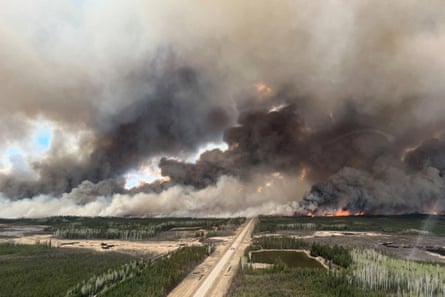Carbon emissions from extreme wildfires increased by 9% last year to reach the sixth highest level on record.
Intense fast-spreading fires devastated huge swathes of South America’s rainforests, dry forests and wetlands and decimated Canada’s northern forests, pushing up the levels of damaging greenhouse gases.
Catastrophic wildfires in the Amazon in 2024 devastated 44.2m acres – a 66% increase in land lost to fires compared with 2023. On the border of Bolivia and Brazil, the Pantanal wetlands and the dry forest of Chiquitano suffered extreme fire events causing soaring carbon emissions.
Wildfires are becoming more frequent and more intense as a result of climate breakdown caused by human emissions, scientists have warned.
According to the State of Wildfires report, an examination of significant wildfires across the world between March 2024 and February 2025, carbon emissions were three times above average in Canada, four times above average in Bolivia and 50% above average in Brazil and Venezuela.
Africa also experienced extreme wildfires, but the analysts said the continent received little international attention, despite driving record forest losses. The severe fires in particular struck Angola and the Democratic Republic of the Congo, where 6% and 2.5% of their total land area was burnt in one week.
Across the continent, about 22m hectares (54 acres) burned in a week.
Multiple deaths were caused by wildfires across the globe. The fires in Nepal killed 100 people. In Los Angeles the wildfires that torched the city and surrounding areas in early spring last year, triggering panicked getaways and turning the skies deep orange, killed 31 people.
As well as deaths, the wildfires caused extreme air pollution events from fine particulate matter, which exceeded World Health Organization guidelines by up to 60 times, the report said.

The report, which was compiled by a global group of experts, used modelling, regional observations and scientific expertise to track wildfires across the world.
“These recent high-impact events align with a growing trend towards increasing extent, intensity and severity of fires globally,” the report said.
“Climate change is intensifying the frequency and severity of drought and fire-favourable weather conditions, lowering vegetation moisture and preconditioning landscapes to burn more regularly, intensely and severely.
“At the same time human activities, including land use and land use change, exacerbate the risk of large, fast moving or intense fires.”
Climate breakdown supercharged many of the infernos across the world, the report said. The burnt area in southern California from the Los Angeles wildfires was 25 times greater as a result of human-induced global heating, while in the north-east Amazon it made extreme wildfires up to 70 times more likely and increased the devastation and burnt land area fourfold, the report said.
Matthew Jones of University of East Anglia, co-author of the report, said the excess in carbon emissions caused by wildfires was akin to the emissions of more than 200 countries.
“Our report shows that the biggest wildfire catastrophes of the 2024-25 fire season were two to three times more likely due to climate change caused by humans, and that the frequency of events like these is set to rise in future unless world leaders take decisive action to rapidly reduce greenhouse gas emissions,” he said.
“Wildfires are themselves contributing to the problem of climate change – in 2024-25 we saw global emissions around 10% above average, mostly due to extreme wildfire seasons in South America and Canada, where forest fires were churning out yet more CO2 emissions to the atmosphere and accelerating the pace of global warming.”

 1 month ago
45
1 month ago
45

















































